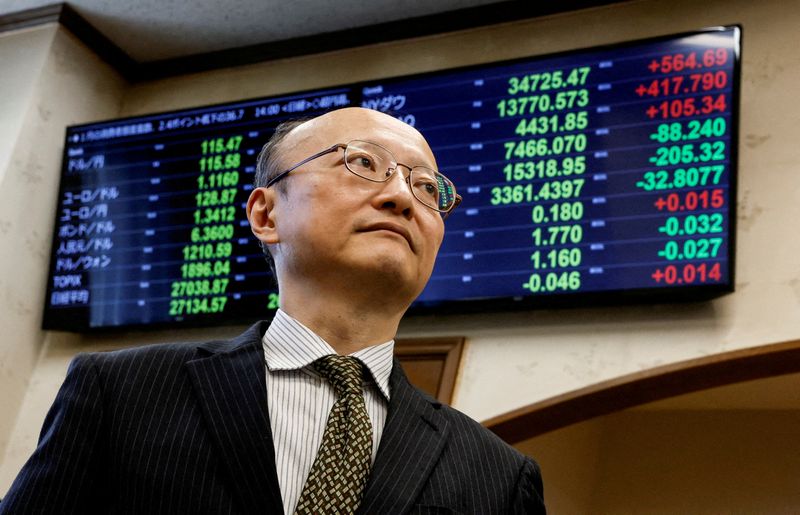Forex
Japan, at G7 meet, renews push to keep yen bears in check

By Leika Kihara
STRESA, Italy (Reuters) – Japan renewed its push to counter excessive yen falls during a weekend gathering of Group of Seven (G7) finance leaders, after a recent rise in bond yields to a 12-year high failed to slow the currency’s stubborn decline.
The effort by the government and central bank underscores the dilemma policymakers face as they seek to balance the need to arrest sharp yen drops that hurt consumption, while keeping borrowing costs low to underpin a fragile economy.
After lobbying by Japan, the G7 finance ministers reaffirmed in a communique issued after their meeting in Italy on Saturday their commitment cautioning against excess volatility in foreign exchange rates.
The agreement came after Japan’s top currency diplomat Masato Kanda on Friday talked up the chance of renewed currency-market intervention, telling reporters that Tokyo stood ready to act “any time” to counter excessive yen movement.
“If there are excessively volatile moves that have an adverse effect on the economy, we need to take action, and doing so would be justified,” he said.
Bank of Japan (BOJ) Governor Kazuo Ueda, who also attended the G7 meeting, signalled that soft consumption or rising bond yields will not get in the way of normalising monetary policy.
Ueda said on Thursday a slump in first-quarter gross domestic product did not change the BOJ’s view that Japan’s economy was on track for a moderate recovery. Analysts have said the BOJ will likely raise interest rates in coming months if the economy moves in line with its forecasts.
He also refrained from speaking against a recent rise in the yield to a 12-year high, that was driven in part by market expectation the BOJ will soon embark on a full-fledged tapering of bond purchases.
“Our basic stance is for long-term interest rates to be set by markets,” Ueda said on Saturday when asked about recent rises in Japan’s long-term rates.
The remarks followed a slew of hawkish signals by the BOJ that has heightened market expectation of a near-term hike in interest rates, or a scale-back in its huge bond purchases.
Ueda has ruled out using monetary policy to influence yen movement. But he escalated his rhetoric against the impact a weak yen could have on inflation, after the currency’s plunge led to suspected yen-buying intervention by the government on April 29 and May 2.
A Reuters poll showed many analysts project the BOJ to hike rates either in the third or fourth quarter this year.
DATA CLOUDS OUTLOOK
Ueda also signalled the BOJ’s readiness to slow but steadily raise interest rates, if inflation durably hits its 2% target in coming years as projected.
But data so far have not been promising. Consumption is weak as wage hikes have yet to catch up to the rising cost of living.
Service-sector inflation, closely watched by the BOJ as a key indicator of underlying price trends, also remains flat.
“Services inflation likely peaked out,” said Junichi Makino, chief economist at SMBC Nikko Securities. “It doesn’t seem like underlying inflation will accelerate towards 2%.”
Given such weak signs in the economy, some analysts are shifting attention to whether the BOJ will taper its bond-buying as part of efforts to slow the yen’s decline.
Ueda has ruled out using the BOJ’s bond-buying as a monetary policy tool, after having exited its radical monetary stimulus in March. But markets remain fixated on the BOJ’s market operations for clues on when it will start to taper.
Some analysts expect the BOJ to decide on slashing bond purchases as early as its next policy meeting in June.
Market expectations of a near-term tapering helped pushed the benchmark 10-year Japanese government bond yield to a 12-year high of 1.005% on Friday.
But the rise in yields has failed to give the yen much boost. It stood at 156.98 to the U.S. dollar on Friday, not far from the more than three-week low of 157.19 touched on Thursday.

“While markets seem excited about the chance of a policy shift, the BOJ is probably cool-headed about all this,” said Daiwa Securities chief market economist Mari Iwashita, who rules out the chance of a taper decision in June.
“Besides, there’s no guarantee such action could stop the yen’s fall.”

 Forex3 years ago
Forex3 years agoForex Today: the dollar is gaining strength amid gloomy sentiment at the start of the Fed’s week

 Forex3 years ago
Forex3 years agoUnbiased review of Pocket Option broker

 Forex3 years ago
Forex3 years agoDollar to pound sterling exchange rate today: Pound plummeted to its lowest since 1985

 Forex3 years ago
Forex3 years agoHow is the Australian dollar doing today?

 Cryptocurrency3 years ago
Cryptocurrency3 years agoWhat happened in the crypto market – current events today

 World3 years ago
World3 years agoWhy are modern video games an art form?

 Commodities3 years ago
Commodities3 years agoCopper continues to fall in price on expectations of lower demand in China

 Economy3 years ago
Economy3 years agoCrude oil tankers double in price due to EU anti-Russian sanctions





















